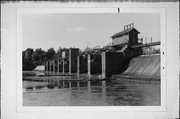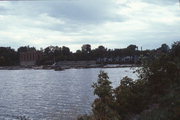Property Record
MILL ST
Architecture and History Inventory
| Historic Name: | Little Chute Dam |
|---|---|
| Other Name: | Little Chute Dam |
| Contributing: | Yes |
| Reference Number: | 52321 |
| Location (Address): | MILL ST |
|---|---|
| County: | Outagamie |
| City: | Little Chute |
| Township/Village: | |
| Unincorporated Community: | |
| Town: | |
| Range: | |
| Direction: | |
| Section: | |
| Quarter Section: | |
| Quarter/Quarter Section: |
| Year Built: | 1933 |
|---|---|
| Additions: | |
| Survey Date: | 1988 |
| Historic Use: | dam/lock |
| Architectural Style: | NA (unknown or not a building) |
| Structural System: | |
| Wall Material: | Concrete |
| Architect: | |
| Other Buildings On Site: | |
| Demolished?: | No |
| Demolished Date: |
| National/State Register Listing Name: | Little Chute Locks and Canal Historic District |
|---|---|
| National Register Listing Date: | 12/7/1993 |
| State Register Listing Date: | 4/10/1992 |
| National Register Multiple Property Name: | Waterway Resources of the Lower Fox River |
| Additional Information: | A 'site file' titled Little Chute Locks and Canal Historic District exists for this property. It contains additional information such as correspondence, newspaper clippings, or historical information. It is a public record and may be viewed in person at the Wisconsin Historical Society, Division of Historic Preservation-Public History. Photo Code: FCS 5/23. This dam is a concrete structure with an overall length of 561 feet. Completed in 1933, it is located immediately southwest of the guard lock. The dam creates the pool that floods the canal in which Little Chute 2 and the Combined Locks are located. It is generally oriented on an NE/SW axis. Anchored to the river's rock bottom, the dam consists of three sections. The southwestern section is a 221 foot spillway and the northeastern section is a 110 foot concrete spillway. The spillways are twenty four feet wide, and fixed the maximum level of the pool the dam creates at 688.88 feet above sea level. The central portion of the dam is 230 feet, and contains nine concrete sluiceways, each of which contains a fourteen by twenty foot, steel Tainter gate. The gates are operated by a "crab," a small electrically operated mechanism that moves from gate to gate on a track. The "crab" contains a winch, wo which the chain on each end of the gate is attached. As the wench is activated, the chain is taken in or let out, and the height of the gate is adjusted accordingly. A steel catwalk, which facilitates inspections and maintenance, extends the length of the dam. Placed atop the dam is a single story front agbled shed that was erected to shelter the electric "crab." Spanning the abutments adjacent to the first gate, the lift house is reached by the catwalk. It is clad with drop siding, roofed with asphalt shingles, and has walls bounded with pilaster strips. The single window in each side wall and the panelled door at the right of the lockside endwall have simple surrounds. A pair of heavy wooden doors in the opposite endwall swing out to allow passage of the "crab" to which ever gate must be adjusted. The need for a new dam was noted by the Corps of Engineers in 1931 when its annual report stated that the old dam was rapidly deteriorating and unable to discharge floor waters as needed. Construction of the new dam was completed in 1933. |
|---|---|
| Bibliographic References: | (A) Annual Report of the Chief of Engineers, 1931: Extract - Report Upon the Improvement of Rivers and Harbors in the Milwaukee, Wis., District (Washington, D.C.: Government Printing Office, 1931), 1470. (B) Annual Report of the Chief of Enginers, 1933: Extract - Report Upon the Improvement of Rivers and Harbors in the Milwaukee, Wis., District (Washington, D.C.: Government Printing Office, 1933), 877. |
| Wisconsin Architecture and History Inventory, State Historic Preservation Office, Wisconsin Historical Society, Madison, Wisconsin |


